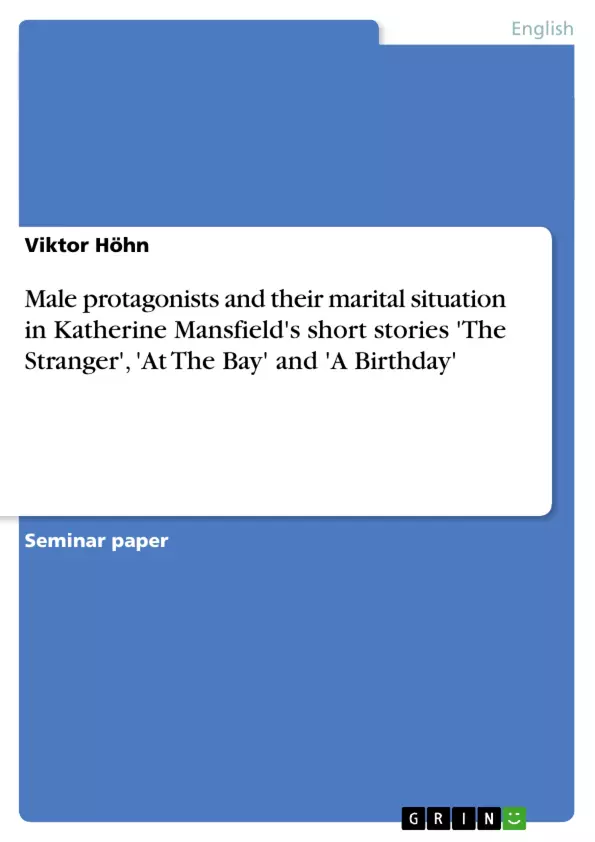[...] Besides, they are in a conflict between a commitment to love and their vivid
interest in art. In other stories, such as “The Singing Lesson” (1920/22), “Poison” (1920/24) and
“Mr. and Mrs. Dove” (1921/1922) Katherine Mansfield focuses on a more romantic notion of
love, presenting both male and female characters experiencing the change between emotional
nearness and distance, between the hopes and anxieties of their dreams. Her short stories that are
set in Bavaria, such as “A Birthday” (1911), “Frau Brechenmacher Attends a Wedding” (1910)
and “The Child-Who-Was-Tired” (1910), deal with marital love and lack this romantic mood. In
a rather satirical style she displays an obviously feminist position as she criticizes male
dominance and the exploitation of women in marital relationships. After Mansfield married John
Middleton Murry in 1918, she writes stories which present her view of marriage – as it appears
in “Bliss” (1918), “The Stranger” (1920), Marriage à la Mode” (1921), “The Man Without a
Temperament” (1920) and “At the Bay” (1921). These narratives are mainly concerned with the
illustration of intimacy and alienation as well as with independence and constraint in marital
relations.
The following discourse is concerned with the male protagonists in Katherine
Mansfield’s short stories “The Stranger”, “At the Bay” and “A Birthday”. It emphasizes intimacy
and alienation in marital partnerships as chief characteristics in these short stories. All three
stories, either set in Europe or New Zealand, present married couples at a certain stage of human
life in unlike contexts. As this discourse is going to reveal each of the three marriages is torn
between intimacy and alienation. It emphasizes on the male protagonists and their marital
relationship, but necessarily also includes a characterisation of their wives. The three chosen
short stories are perfect examples for such an analysis as their married couples have basic
elements in common, such as age, social status, family situation and the acceptance of traditional
gender-specific role models. Thus their personalities and emotional conflicts to which this
discourse directs its principal attention are not essentially distinguished by these aspects.
1 The following paragraph is based on: Dada-Büchel, Marianne. Katherine Mansfield’s Dual Vision: Concepts of
Duality and Unity in Her Fictional Work. Andreas Fischer (Hrsg.). Thübingen: francke verlag, 1995. p. 127-128.
Inhaltsverzeichnis (Table of Contents)
- I. Introduction
- II. 1 John and Janey Hammond in “The Stranger”
- II. 2 Stanley and Linda Burnell in "At the Bay"
- II. 3 Andreas and Anna Binzer in "A Birthday"
- III. Conclusion
- IV. Bibliography
Zielsetzung und Themenschwerpunkte (Objectives and Key Themes)
This work focuses on the male protagonists in Katherine Mansfield's short stories "The Stranger", "At the Bay" and "A Birthday", examining their marital relationships and emphasizing the themes of intimacy and alienation within these partnerships. The analysis explores the male protagonists' characters and their emotional conflicts, while considering the role of their wives in these relationships. It highlights the complexities of marriage and the challenges faced by couples, particularly within the context of traditional gender roles.
- Intimacy and Alienation in Marriage
- Masculinity and Traditional Gender Roles
- The Impact of Social Context on Relationships
- The Dynamics of Power and Control within Couples
- The Exploration of Emotional Complexity in Marriage
Zusammenfassung der Kapitel (Chapter Summaries)
- I. Introduction: This chapter provides an overview of Katherine Mansfield's work, focusing on her recurring themes of friendship, marriage, and family life. It highlights her interest in male-female relationships and the perspectives she presents within her stories.
- II. 1 John and Janey Hammond in “The Stranger”: This chapter examines the relationship of John and Janey Hammond, a married couple reunited after a ten-month separation. It analyzes John's character, highlighting his masculine traits and his underlying insecurities. The chapter explores the dynamics of their reunion and the tension between their desire for intimacy and their feelings of alienation.
- II. 2 Stanley and Linda Burnell in "At the Bay": This chapter focuses on the relationship of Stanley and Linda Burnell, a married couple experiencing a period of disillusionment and estrangement. It examines the impact of their social context and the challenges they face in maintaining their marriage. The chapter explores the complexities of their emotions and the shifting power dynamics within their relationship.
- II. 3 Andreas and Anna Binzer in "A Birthday": This chapter analyzes the relationship of Andreas and Anna Binzer, a couple celebrating Anna's birthday. It examines the dynamics of their marriage and the underlying tensions that exist between them. The chapter explores their individual perspectives and the conflicting emotions they experience within their relationship.
Schlüsselwörter (Keywords)
The work focuses on key concepts such as intimacy, alienation, masculinity, marriage, gender roles, social context, power dynamics, emotional complexity, and the short stories of Katherine Mansfield. It analyzes the character portrayals of the male protagonists and their marital relationships, providing insights into the complexities of human relationships and the challenges faced by couples within the framework of traditional societal norms.
- Arbeit zitieren
- Viktor Höhn (Autor:in), 2003, Male protagonists and their marital situation in Katherine Mansfield's short stories 'The Stranger', 'At The Bay' and 'A Birthday', München, GRIN Verlag, https://www.grin.com/document/23378



